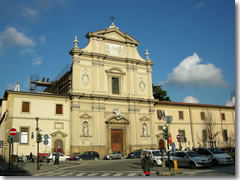
San Marco. (Photo by Sailko)This gorgeous monastery—designed by the premier early Renaissance architect Michelozzo in 1436–46 for his patron, Cosimo Il Vecchio de' Medici, who would come here on soul-searching retreats—is renowned for two famous former residents, one saintly, the other...not so much.
Many of the walls—of the public rooms, the cloisters, and even individual monks' cells—were decorated by the monastery's most illustrious resident, the brilliant Renaissance monk and painter Fra' Angelico.
The "Angelic Brother"—born Guido di Pietro in the hills near Florence—is actually known to more Italians by his honorific title, Beato Angelico (beatification is one step below sainthood, and quite an honor for a man who had no miracles to his credit and was famed only for his skills as an artist—though possessing a serenely pious and humble temperament didn't hurt).
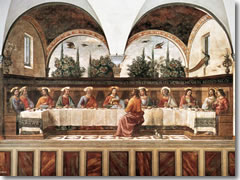
The Last Supper by Domenico Ghirlandaio.One of Fra' Angelico's master works, an amazing Crucifixion, fills one wall of the Chapter House. He also frescoed the corners of the Cloisters of S. Antonio.
The monastery has spent the past century gathering more of the artist's works (and those of some contemporaries), which are now displayed in a small museum in the old Pilgrim's Hospice downstairs
It's not an Angelico, but also downstairs don't miss the Small Refectory (dining room), on the wall of which, in keeping with tradition, Renaissance great Domenico Ghirlandaio painted a scene of the Cenacolo (Last Supper).
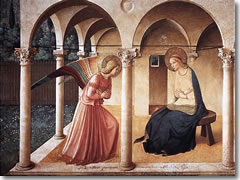
The Annunciation by Fra' Angelico.Upstairs in the dormitory is where San Marco really shines.
As you reach the top of the stairs to San Marco's star sight, the Dormitory of monks' cells, you'll see above you Fra' Angelico's Annunciation, one of his most famous works.
At the top of the stairs are two hallways: one leading off the right, the other stretching directly before you. Go straight first.
Fra' Angelico himself frescoed the Madonna Enthroned with Saints on the right wall, and all but the second of the cells down the left side of the hall (cells no. 1-11)—though an assistant might have done Madonna and Child in cell no. 11.
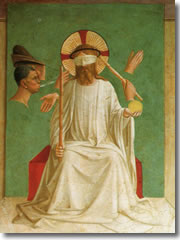
A detail from the surrealistic The Mocking of Christ, a Fra' Angelico in cell 7 of the San Marco Dormitorio.Assistants also frescoed the scenes in the cells on the right side of the hall (nos. 23–29).
At the end of this hall, turn right but not before popping into cell no. 22 (on the corner on the right) to see, under glass, the remains—complete with a bit of 13th century fresco—of the earlier convent upon which Michelozzo built this version.
Halfway down this side hall on the right is cell no. 17, which also contains some fragments of paintings from the earlier convent. These images—probably of San Antonio Abate and the convent's founder, Silvestro Gozzolini—were painted sometime between 1290 and 1310 and are among the oldest surviving frescoes in Florence.
At the end of this corridor is a suite of cells (nos. 12–14) that were once occupied by Fra' Girolamo Savonarola from Ferrara (decorated with a few portraits of him by another resident monk, and Savonarola acolyte, Fra' Bartolomeo.)
Known (later) as the Mad Monk, iron-fisted Savonarola commanded his short-lived theocratic rule over Florence from this modest suite of cells. This chapter of Florentine history is so odd and so compelling, Savonarola gets his very own page describing his autocratic reign of theological terror.
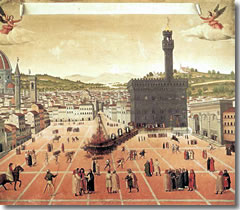
The execution of Girolamo Savonarola on Piazza della Signoria, an anonymous painting of 1498.(To encourage you to click and read more about Savonarola, I offer this juicy tidbit: in the suite of cells are some of the furniture, Crucifix, etc. that actually belonged to the Mad Monk—including the uncomfortable little three-legged, hard-backed stools that have since been named after him. There's also a small, anonymous painting that is a kind of aerial view of Piazza della Signoria. Look more closely at it. In the center of the piazza is a bonfire. Atop that bonfire is Savonarola.) » more
Retracing your steps to the top of the stairs, turn left down the final corridor, the cells again frescoed mostly by Fra' Angelico' assistants.
At the end of the corridor, to the right, is another tiny suite of cells—this time decorated with an Adoration of the Magi by Fra' Angelico's star pupil, Benozzo Gozzoli.
These two rooms were the once set aside for Cosimo Il Vecchio and his frequent contemplative retreats into the monastery he financed.
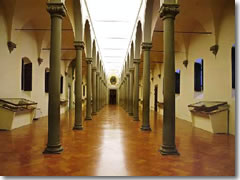
The Michelozzo library at San Marco.Returning back up this corridor to the stairs, look to the left halfway along to see the beautiful Michelozzo-designed Library stretching off into the distance. This was a favored place for Lorenzo de' Medici and his humanist friends to meet, consult ancient texts, and philosophize.
When it's open, you can wander amid the columns and peruse glass tables filled with gorgeous medieval illuminated manuscripts. Most of these came from convents and churches that were suppressed in the 19th century (thanks, Napoleon).
Unfortunately, little of the library's original collection remains—another victim of those 19th century suppressions. I point this out since it is heartbreaking to think about it in light of the following fact: this collection, in this space, constituted Europe's very first public library.
The church itself is no great shakes—dark and moody, with only a few minor works.
It was redesigned by Giambologna, and contains some decent works by his late Renaissance contemporaries, like Alessandro Allori and Il Passignano.
There are also a few nice pieces by Fra' Bartolomeo (don't hold the Savonarola connection against the poor guy; Botticelli became a fervent Savonarola-follower, too) and a cool 8th century mosaic of the Madonna Praying from Constantinople (look closely: you can see the seam where they cut it in half to transport it over here).
In 1984, the church—perhaps embarrassed not to have anything by its most famous one-time resident—placed a small Fra' Angelico Crucifix above the altar.
Piazza San Marco 3
tel. +39-055-238-8608
www.polomuseale.firenze.it
Mon–Fri 8:15am–1:50pm, Sat–Sun 8:15am–4:50pm
Closed 2nd and 4th Mon of each month
Closed 1st, 3rd, 5th Sun of each month
€4
Bus: 307A; 6, 7, 10, 14, 19, 20, 23, 25, 31
Hop-on/hop-off: Piazza Libertà Viale Matteotti (C), Libertà (A, B); Independenza (B)
Planning your day: Give it about 1 hour—there are lots of frescoed cells to wander in and out of, plus the rooms filled with paintings, and you should take some time to pop into the conventual church next-door.
The ticket office closes 30 minutes before the museum..
The San Marco Museum is covered by the Firenze Card—free admission, no waiting in line. » more
Take a guided tour of Museo San Marco with one of our partners:
Share this page
Search ReidsItaly.com
Piazza San Marco 3
tel. +39-055-238-8608
www.polomuseale.firenze.it
Mon–Fri 8:15am–1:50pm, Sat–Sun 8:15am–4:50pm
Closed 2nd and 4th Mon of each month
Closed 1st, 3rd, 5th Sun of each month
€4
With Firenze Card: Free
Bus: 307A; 6, 7, 10, 14, 19, 20, 23, 25, 31
Hop-on/hop-off: Piazza Libertà Viale Matteotti (C), Libertà (A, B); Independenza (B)